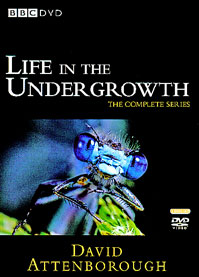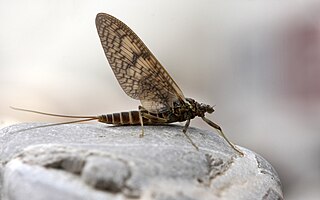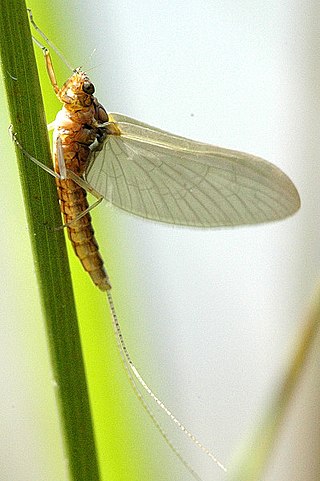
Mayflies are aquatic insects belonging to the order Ephemeroptera. This order is part of an ancient group of insects termed the Palaeoptera, which also contains dragonflies and damselflies. Over 3,000 species of mayfly are known worldwide, grouped into over 400 genera in 42 families.

Aquatic insects or water insects live some portion of their life cycle in the water. They feed in the same ways as other insects. Some diving insects, such as predatory diving beetles, can hunt for food underwater where land-living insects cannot compete.

Life in the Undergrowth is a BBC nature documentary series written and presented by David Attenborough, first transmitted in the UK from 23 November 2005.

Baetidae is a family of mayflies with about 1000 described species in 110 genera distributed worldwide. These are among the smallest of mayflies, adults rarely exceeding 10 mm in length excluding the two long slender tails and sometimes much smaller, and members of the family are often referred to as small mayflies or small minnow mayflies. Most species have long oval forewings with very few cross veins but the hindwings are usually very small or even absent. The males often have very large eyes, shaped like turrets above the head.

The Heptageniidae are a family of mayflies with over 500 described species mainly distributed in the Holarctic, Oriental, and Afrotropical regions, and also present in the Central American Tropics and extreme northern South America. The group is sometimes referred to as flat-headed mayflies or stream mayflies. These are generally rather small mayflies with three long tails. The wings are usually clear with prominent venation although species with variegated wings are known. As in most mayflies, the males have large compound eyes, but not divided into upper and lower parts.

Caenis is a genus of mayflies. They are very small in size, sometimes with a body of only an 1/8 of an inch (3.2 mm).

Pannota is a suborder of mayflies. One of the differences between this suborder and its sister group Schistonota concerns the degree of fusion of the wing pads in the final-stage nymph; in Schistonota, the degree of fusion along the mesothorax is more than half the fore-wing length while in Pannota the degree of fusion is less than half that length. Other differences between the two groups include the morphology of the gills and also behavioural differences. Schistonota nymphs are mostly active swimmers, burrowers and sprawlers, while Pannota nymphs are more passive, slow-moving crawlers.

Caenoidea is a superfamily of mayflies in the suborder Pannota. Members of this superfamily can be distinguished from those of Ephemerelloidea by the fact that the gills of the nymphs are filamentous.

Ephemera vulgata is a species of mayfly in the genus Ephemera. This mayfly breeds in stationary water in slow rivers and in ponds, the nymphs developing in the mud.
Brachycercus is a genus of small squaregilled mayflies in the family Caenidae. There are at least four described species in Brachycercus.
Irpacaenis is a genus of small squaregilled mayflies in the family Caenidae. There are at least three described species in Irpacaenis.
Tasmanocoenis is a genus of small squaregilled mayflies in the family Caenidae. There are about seven described species in Tasmanocoenis.
Caenis hilaris is a species of small squaregilled mayfly in the family Caenidae. It is found in North America.
Caenis luctuosa is a species of small squaregilled mayfly in the family Caenidae. It is found in Europe.
Caenis macafferti is a species of small squaregilled mayfly in the family Caenidae. It is found in North America.
Caenis tardata is a species of small squaregilled mayfly in the family Caenidae. It is found in North America.

Pisciforma is a suborder of mayflies in the order Ephemeroptera. There are at least 410 described species in Pisciforma.

Furcatergalia is a suborder of mayflies in the order Ephemeroptera. There are about 14 families and at least 1,700 described species in Furcatergalia.
Brachycercus harrisella is a species of mayfly belonging to the family Caenidae.







